

The American housing market took off during the early months of the COVID-19 pandemic. The homeownership rate – or the share of housing units occupied by their owner – jumped by 2.6 percentage points from the first quarter to the second quarter of 2020, by far the largest increase ever recorded. By the end of 2020, there were 2.1 million more homeowners in the United States than there were a year earlier.
The surge in home sales was fueled by several factors, including historically low mortgage rates, and, as some experts speculate, the pandemic, which led many Americans to re-evaluate where and how they live. Here is a look at the mortgage rate in America every year since 1972.
Nationwide, the homeownership rate stands at 64.4%, according to the latest American Community Survey data from the U.S. Census Bureau. This rate varies substantially across the country, however, and in some major metropolitan areas, homeownership is far less common than it is nationwide.
Using census data, 24/7 Wall St. identified the 50 metro areas with the lowest homeownership rates. Metro areas are ranked by the share of housing units occupied by their owners.
Among the cities on this list, homeownership rates range from 59.5% to 48.7%. The largest share of these cities are in the West, including 14 in California alone.
Homeownership can be expensive, and in most of the metro areas on this list, the typical household earns less than the national median household income of $64,995. The low incomes in these metro areas may make homeownership less affordable for larger shares of the population. Here is a look at the 20 cities where the middle class can no longer afford housing.
Many of the metro areas on this list are home to large colleges or universities. Because a significant share of the population in college towns reside there temporarily, the transient population are more likely to rent a home than buy one. These places include Ithaca, New York, home to Cornell University and Ithaca College; Lawrence, Kansas, home to the University of Kansas; and Bloomington, Indiana, home to Indiana University.
Click here to see the cities where the fewest people own their homes
Click here to read our detailed methodology

50. Gainesville, FL
> Homeownership rate: 59.5%
> Median home value: $181,700 — 187th highest of 384 metros
> Median monthly housing costs (w/ a mortgage): $1,343 — 179th lowest of 384 metros (tied)
> Median monthly housing costs (no mortgage): $425 — 130th lowest of 384 metros
> Median household income: $47,848 — 35th lowest of 384 metros
[in-text-ad]
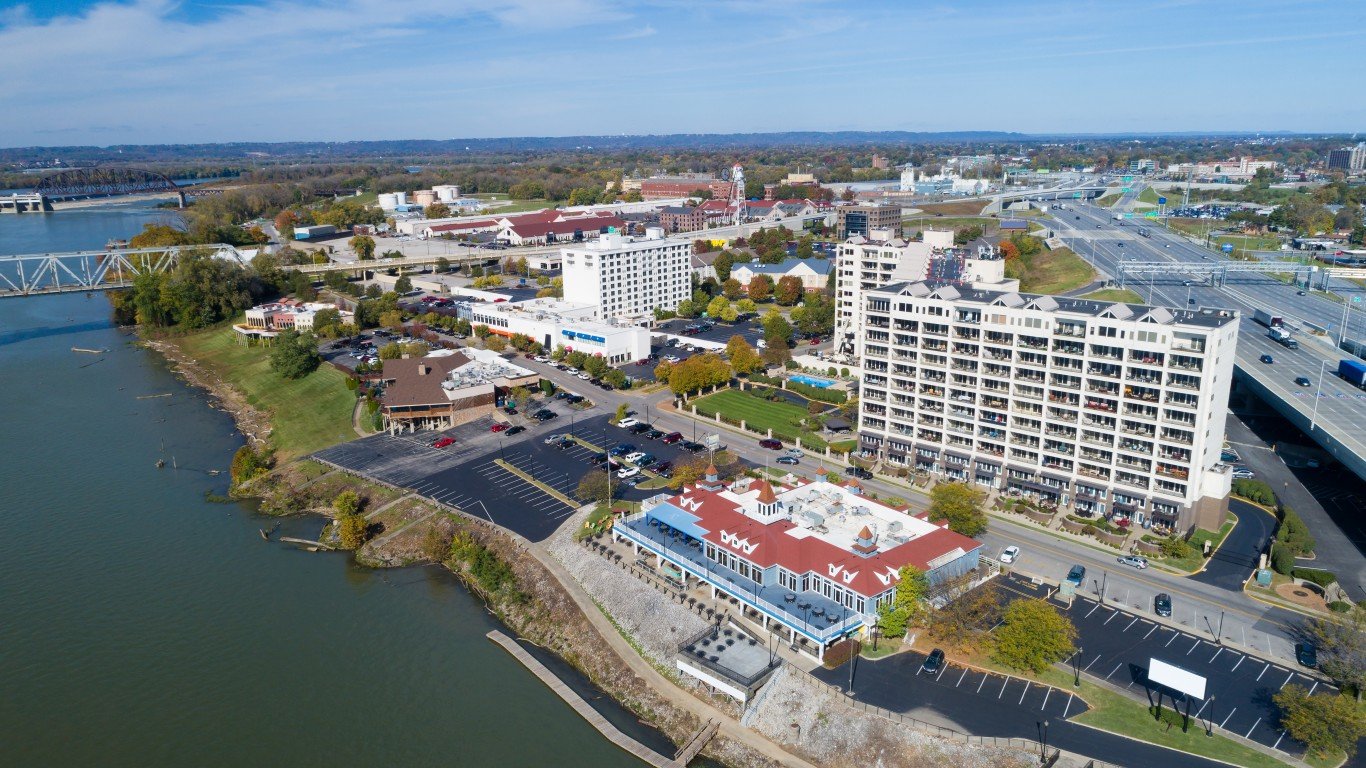
49. Clarksville, TN-KY
> Homeownership rate: 59.3%
> Median home value: $165,100 — 160th lowest of 384 metros
> Median monthly housing costs (w/ a mortgage): $1,242 — 114th lowest of 384 metros
> Median monthly housing costs (no mortgage): $397 — 86th lowest of 384 metros
> Median household income: $54,911 — 135th lowest of 384 metros
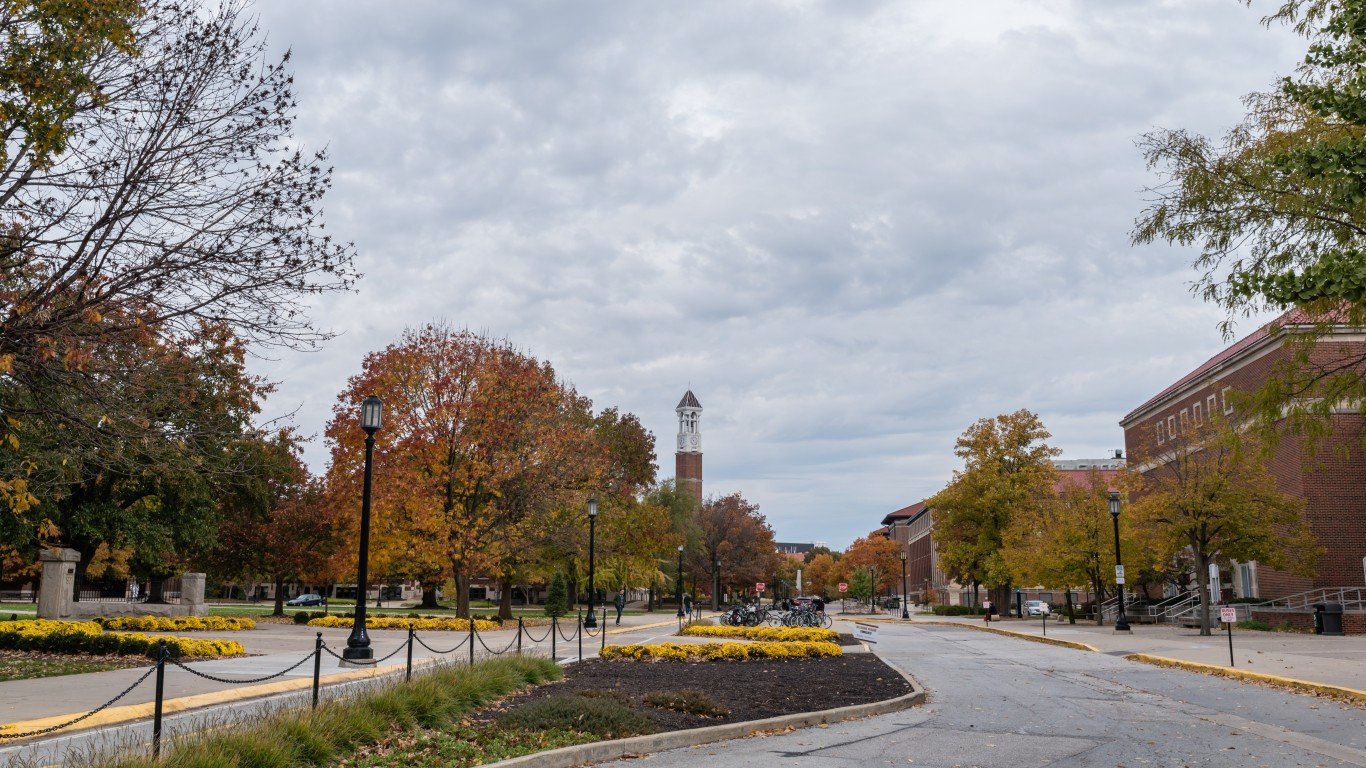
48. Lafayette-West Lafayette, IN
> Homeownership rate: 59.2%
> Median home value: $152,500 — 114th lowest of 384 metros
> Median monthly housing costs (w/ a mortgage): $1,120 — 47th lowest of 384 metros
> Median monthly housing costs (no mortgage): $399 — 93rd lowest of 384 metros (tied)
> Median household income: $52,826 — 97th lowest of 384 metros

47. Eugene-Springfield, OR
> Homeownership rate: 59.1%
> Median home value: $280,000 — 68th highest of 384 metros
> Median monthly housing costs (w/ a mortgage): $1,586 — 92nd highest of 384 metros (tied)
> Median monthly housing costs (no mortgage): $530 — 111th highest of 384 metros (tied)
> Median household income: $54,942 — 137th lowest of 384 metros
[in-text-ad-2]

46. Fairbanks, AK
> Homeownership rate: 58.9%
> Median home value: $240,300 — 107th highest of 384 metros
> Median monthly housing costs (w/ a mortgage): $1,824 — 49th highest of 384 metros
> Median monthly housing costs (no mortgage): $620 — 49th highest of 384 metros
> Median household income: $76,464 — 39th highest of 384 metros

45. Bakersfield, CA
> Homeownership rate: 58.9%
> Median home value: $226,600 — 121st highest of 384 metros (tied)
> Median monthly housing costs (w/ a mortgage): $1,586 — 92nd highest of 384 metros (tied)
> Median monthly housing costs (no mortgage): $468 — 185th lowest of 384 metros (tied)
> Median household income: $54,851 — 129th lowest of 384 metros
[in-text-ad]

44. Modesto, CA
> Homeownership rate: 58.7%
> Median home value: $314,100 — 40th highest of 384 metros
> Median monthly housing costs (w/ a mortgage): $1,732 — 63rd highest of 384 metros
> Median monthly housing costs (no mortgage): $530 — 111th highest of 384 metros (tied)
> Median household income: $62,873 — 125th highest of 384 metros

43. Missoula, MT
> Homeownership rate: 58.6%
> Median home value: $302,200 — 47th highest of 384 metros
> Median monthly housing costs (w/ a mortgage): $1,626 — 80th highest of 384 metros
> Median monthly housing costs (no mortgage): $520 — 127th highest of 384 metros (tied)
> Median household income: $56,247 — 155th lowest of 384 metros

42. Austin-Round Rock-Georgetown, TX
> Homeownership rate: 58.6%
> Median home value: $303,300 — 46th highest of 384 metros
> Median monthly housing costs (w/ a mortgage): $1,976 — 30th highest of 384 metros (tied)
> Median monthly housing costs (no mortgage): $745 — 21st highest of 384 metros
> Median household income: $80,852 — 26th highest of 384 metros
[in-text-ad-2]

41. Columbia, MO
> Homeownership rate: 58.4%
> Median home value: $189,900 — 172nd highest of 384 metros
> Median monthly housing costs (w/ a mortgage): $1,364 — 190th highest of 384 metros
> Median monthly housing costs (no mortgage): $475 — 187th highest of 384 metros (tied)
> Median household income: $57,980 — 181st lowest of 384 metros

40. Bloomington, IN
> Homeownership rate: 58.3%
> Median home value: $177,700 — 187th lowest of 384 metros
> Median monthly housing costs (w/ a mortgage): $1,198 — 86th lowest of 384 metros
> Median monthly housing costs (no mortgage): $453 — 161st lowest of 384 metros (tied)
> Median household income: $52,226 — 90th lowest of 384 metros
[in-text-ad]

39. Carson City, NV
> Homeownership rate: 58.2%
> Median home value: $299,900 — 50th highest of 384 metros
> Median monthly housing costs (w/ a mortgage): $1,489 — 133rd highest of 384 metros
> Median monthly housing costs (no mortgage): $438 — 141st lowest of 384 metros (tied)
> Median household income: $58,305 — 185th lowest of 384 metros

38. Tallahassee, FL
> Homeownership rate: 58.2%
> Median home value: $187,400 — 177th highest of 384 metros
> Median monthly housing costs (w/ a mortgage): $1,372 — 186th highest of 384 metros
> Median monthly housing costs (no mortgage): $418 — 122nd lowest of 384 metros (tied)
> Median household income: $53,423 — 107th lowest of 384 metros

37. Reno, NV
> Homeownership rate: 58.2%
> Median home value: $359,500 — 32nd highest of 384 metros
> Median monthly housing costs (w/ a mortgage): $1,714 — 66th highest of 384 metros
> Median monthly housing costs (no mortgage): $459 — 169th lowest of 384 metros (tied)
> Median household income: $68,214 — 83rd highest of 384 metros
[in-text-ad-2]

36. El Centro, CA
> Homeownership rate: 58.1%
> Median home value: $206,700 — 148th highest of 384 metros
> Median monthly housing costs (w/ a mortgage): $1,463 — 148th highest of 384 metros
> Median monthly housing costs (no mortgage): $468 — 185th lowest of 384 metros (tied)
> Median household income: $46,222 — 17th lowest of 384 metros

35. Jonesboro, AR
> Homeownership rate: 58.1%
> Median home value: $136,000 — 59th lowest of 384 metros
> Median monthly housing costs (w/ a mortgage): $1,052 — 20th lowest of 384 metros
> Median monthly housing costs (no mortgage): $345 — 21st lowest of 384 metros (tied)
> Median household income: $47,610 — 30th lowest of 384 metros
[in-text-ad]

34. Stockton, CA
> Homeownership rate: 57.7%
> Median home value: $367,900 — 28th highest of 384 metros
> Median monthly housing costs (w/ a mortgage): $1,971 — 32nd highest of 384 metros
> Median monthly housing costs (no mortgage): $550 — 88th highest of 384 metros (tied)
> Median household income: $68,628 — 78th highest of 384 metros

33. Urban Honolulu, HI
> Homeownership rate: 57.5%
> Median home value: $702,300 — 4th highest of 384 metros
> Median monthly housing costs (w/ a mortgage): $2,641 — 9th highest of 384 metros
> Median monthly housing costs (no mortgage): $614 — 51st highest of 384 metros
> Median household income: $87,722 — 11th highest of 384 metros

32. Visalia, CA
> Homeownership rate: 57.1%
> Median home value: $223,600 — 125th highest of 384 metros
> Median monthly housing costs (w/ a mortgage): $1,478 — 139th highest of 384 metros (tied)
> Median monthly housing costs (no mortgage): $435 — 139th lowest of 384 metros (tied)
> Median household income: $52,534 — 94th lowest of 384 metros
[in-text-ad-2]

31. Corvallis, OR
> Homeownership rate: 56.8%
> Median home value: $357,900 — 33rd highest of 384 metros
> Median monthly housing costs (w/ a mortgage): $1,776 — 57th highest of 384 metros
> Median monthly housing costs (no mortgage): $594 — 62nd highest of 384 metros (tied)
> Median household income: $65,142 — 103rd highest of 384 metros

30. Columbus, GA-AL
> Homeownership rate: 56.7%
> Median home value: $146,300 — 93rd lowest of 384 metros
> Median monthly housing costs (w/ a mortgage): $1,290 — 144th lowest of 384 metros (tied)
> Median monthly housing costs (no mortgage): $382 — 59th lowest of 384 metros (tied)
> Median household income: $48,903 — 48th lowest of 384 metros
[in-text-ad]

29. Fayetteville, NC
> Homeownership rate: 56.6%
> Median home value: $146,800 — 96th lowest of 384 metros
> Median monthly housing costs (w/ a mortgage): $1,259 — 130th lowest of 384 metros
> Median monthly housing costs (no mortgage): $420 — 126th lowest of 384 metros (tied)
> Median household income: $50,133 — 60th lowest of 384 metros

28. San Jose-Sunnyvale-Santa Clara, CA
> Homeownership rate: 56.6%
> Median home value: $1,041,800 — the highest of 384 metros
> Median monthly housing costs (w/ a mortgage): $3,505 — the highest of 384 metros
> Median monthly housing costs (no mortgage): $829 — 10th highest of 384 metros
> Median household income: $129,343 — the highest of 384 metros
27. Killeen-Temple, TX
> Homeownership rate: 56.3%
> Median home value: $150,300 — 107th lowest of 384 metros
> Median monthly housing costs (w/ a mortgage): $1,350 — 184th lowest of 384 metros (tied)
> Median monthly housing costs (no mortgage): $476 — 184th highest of 384 metros (tied)
> Median household income: $55,306 — 146th lowest of 384 metros
[in-text-ad-2]

26. Lubbock, TX
> Homeownership rate: 56.2%
> Median home value: $146,400 — 94th lowest of 384 metros
> Median monthly housing costs (w/ a mortgage): $1,468 — 144th highest of 384 metros
> Median monthly housing costs (no mortgage): $507 — 139th highest of 384 metros (tied)
> Median household income: $53,003 — 102nd lowest of 384 metros

25. Fargo, ND-MN
> Homeownership rate: 55.9%
> Median home value: $225,600 — 123rd highest of 384 metros
> Median monthly housing costs (w/ a mortgage): $1,553 — 106th highest of 384 metros (tied)
> Median monthly housing costs (no mortgage): $548 — 91st highest of 384 metros (tied)
> Median household income: $65,995 — 96th highest of 384 metros
[in-text-ad]

24. Valdosta, GA
> Homeownership rate: 55.8%
> Median home value: $137,300 — 62nd lowest of 384 metros (tied)
> Median monthly housing costs (w/ a mortgage): $1,161 — 67th lowest of 384 metros
> Median monthly housing costs (no mortgage): $378 — 54th lowest of 384 metros (tied)
> Median household income: $43,859 — 7th lowest of 384 metros

23. Watertown-Fort Drum, NY
> Homeownership rate: 55.7%
> Median home value: $150,100 — 105th lowest of 384 metros (tied)
> Median monthly housing costs (w/ a mortgage): $1,292 — 148th lowest of 384 metros (tied)
> Median monthly housing costs (no mortgage): $478 — 180th highest of 384 metros (tied)
> Median household income: $54,726 — 128th lowest of 384 metros

22. Albany, GA
> Homeownership rate: 55.6%
> Median home value: $120,200 — 29th lowest of 384 metros
> Median monthly housing costs (w/ a mortgage): $1,185 — 77th lowest of 384 metros (tied)
> Median monthly housing costs (no mortgage): $440 — 146th lowest of 384 metros (tied)
> Median household income: $46,323 — 18th lowest of 384 metros
[in-text-ad-2]
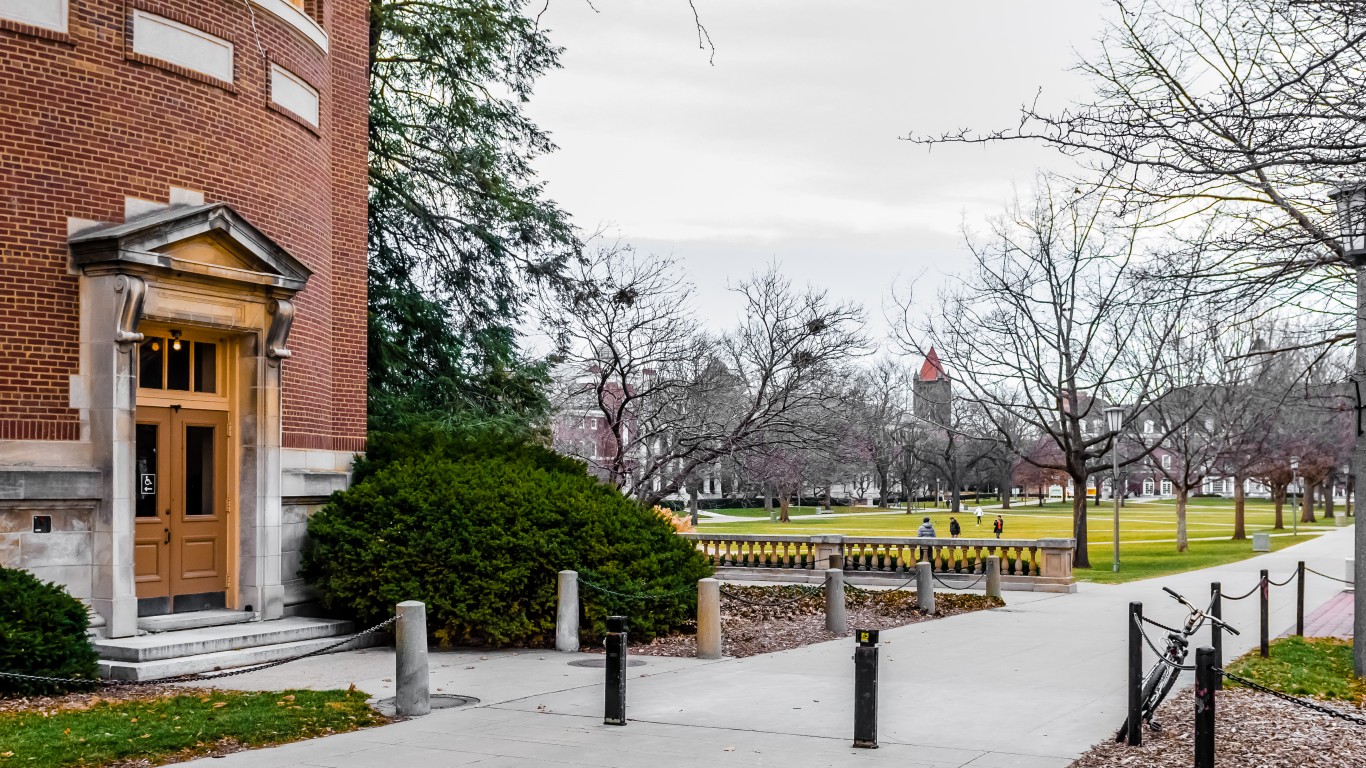
21. Champaign-Urbana, IL
> Homeownership rate: 55.3%
> Median home value: $163,900 — 158th lowest of 384 metros
> Median monthly housing costs (w/ a mortgage): $1,396 — 174th highest of 384 metros
> Median monthly housing costs (no mortgage): $575 — 73rd highest of 384 metros (tied)
> Median household income: $54,897 — 133rd lowest of 384 metros

20. Grand Forks, ND-MN
> Homeownership rate: 55.2%
> Median home value: $195,500 — 163rd highest of 384 metros
> Median monthly housing costs (w/ a mortgage): $1,426 — 157th highest of 384 metros (tied)
> Median monthly housing costs (no mortgage): $506 — 141st highest of 384 metros
> Median household income: $55,122 — 145th lowest of 384 metros
[in-text-ad]

19. San Francisco-Oakland-Berkeley, CA
> Homeownership rate: 55.0%
> Median home value: $888,500 — 2nd highest of 384 metros
> Median monthly housing costs (w/ a mortgage): $3,207 — 2nd highest of 384 metros
> Median monthly housing costs (no mortgage): $765 — 14th highest of 384 metros (tied)
> Median household income: $110,837 — 2nd highest of 384 metros

18. Las Vegas-Henderson-Paradise, NV
> Homeownership rate: 54.8%
> Median home value: $285,100 — 63rd highest of 384 metros
> Median monthly housing costs (w/ a mortgage): $1,567 — 97th highest of 384 metros (tied)
> Median monthly housing costs (no mortgage): $438 — 141st lowest of 384 metros (tied)
> Median household income: $61,048 — 156th highest of 384 metros

17. Athens-Clarke County, GA
> Homeownership rate: 54.6%
> Median home value: $193,700 — 165th highest of 384 metros (tied)
> Median monthly housing costs (w/ a mortgage): $1,358 — 191st lowest of 384 metros
> Median monthly housing costs (no mortgage): $461 — 173rd lowest of 384 metros (tied)
> Median household income: $49,503 — 53rd lowest of 384 metros
[in-text-ad-2]

16. Lawton, OK
> Homeownership rate: 54.4%
> Median home value: $121,500 — 34th lowest of 384 metros
> Median monthly housing costs (w/ a mortgage): $1,165 — 69th lowest of 384 metros
> Median monthly housing costs (no mortgage): $386 — 68th lowest of 384 metros
> Median household income: $52,219 — 89th lowest of 384 metros

15. Jacksonville, NC
> Homeownership rate: 54.2%
> Median home value: $162,400 — 151st lowest of 384 metros (tied)
> Median monthly housing costs (w/ a mortgage): $1,272 — 135th lowest of 384 metros (tied)
> Median monthly housing costs (no mortgage): $396 — 84th lowest of 384 metros (tied)
> Median household income: $51,560 — 81st lowest of 384 metros
[in-text-ad]
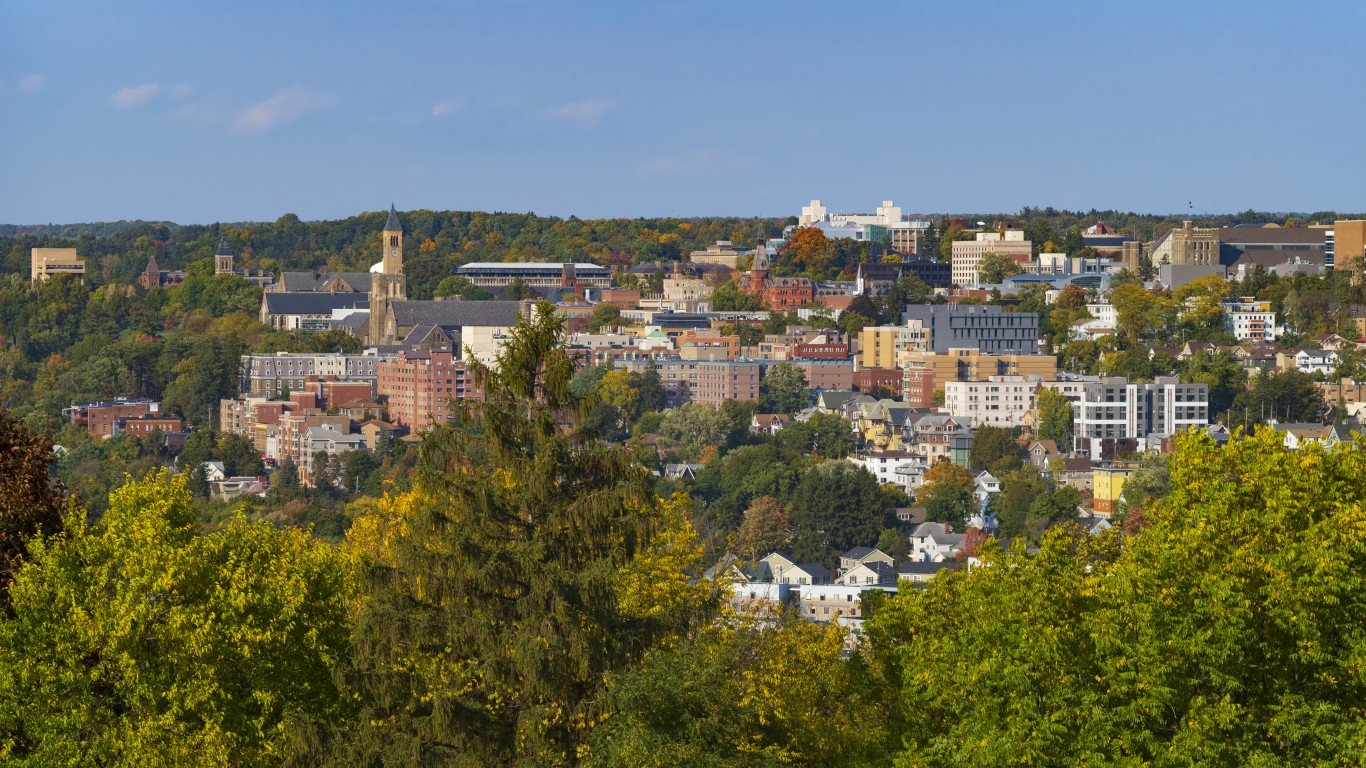
14. Ithaca, NY
> Homeownership rate: 54.0%
> Median home value: $218,700 — 132nd highest of 384 metros (tied)
> Median monthly housing costs (w/ a mortgage): $1,691 — 69th highest of 384 metros (tied)
> Median monthly housing costs (no mortgage): $673 — 33rd highest of 384 metros
> Median household income: $61,361 — 153rd highest of 384 metros

13. San Diego-Chula Vista-Carlsbad, CA
> Homeownership rate: 53.9%
> Median home value: $595,600 — 12th highest of 384 metros
> Median monthly housing costs (w/ a mortgage): $2,653 — 8th highest of 384 metros
> Median monthly housing costs (no mortgage): $642 — 41st highest of 384 metros
> Median household income: $82,426 — 22nd highest of 384 metros

12. Fresno, CA
> Homeownership rate: 53.7%
> Median home value: $271,000 — 74th highest of 384 metros
> Median monthly housing costs (w/ a mortgage): $1,660 — 76th highest of 384 metros
> Median monthly housing costs (no mortgage): $499 — 152nd highest of 384 metros (tied)
> Median household income: $57,109 — 168th lowest of 384 metros
[in-text-ad-2]
11. Hanford-Corcoran, CA
> Homeownership rate: 53.6%
> Median home value: $227,400 — 120th highest of 384 metros
> Median monthly housing costs (w/ a mortgage): $1,478 — 139th highest of 384 metros (tied)
> Median monthly housing costs (no mortgage): $461 — 173rd lowest of 384 metros (tied)
> Median household income: $61,556 — 150th highest of 384 metros

10. Greenville, NC
> Homeownership rate: 52.6%
> Median home value: $146,700 — 95th lowest of 384 metros
> Median monthly housing costs (w/ a mortgage): $1,279 — 139th lowest of 384 metros
> Median monthly housing costs (no mortgage): $448 — 154th lowest of 384 metros (tied)
> Median household income: $49,337 — 50th lowest of 384 metros
[in-text-ad]

9. Santa Maria-Santa Barbara, CA
> Homeownership rate: 52.3%
> Median home value: $610,300 — 9th highest of 384 metros
> Median monthly housing costs (w/ a mortgage): $2,447 — 13th highest of 384 metros
> Median monthly housing costs (no mortgage): $662 — 35th highest of 384 metros
> Median household income: $78,925 — 28th highest of 384 metros

8. Merced, CA
> Homeownership rate: 52.2%
> Median home value: $268,800 — 77th highest of 384 metros
> Median monthly housing costs (w/ a mortgage): $1,536 — 112th highest of 384 metros
> Median monthly housing costs (no mortgage): $473 — 192nd highest of 384 metros
> Median household income: $56,330 — 157th lowest of 384 metros
7. Salinas, CA
> Homeownership rate: 51.8%
> Median home value: $559,400 — 13th highest of 384 metros
> Median monthly housing costs (w/ a mortgage): $2,352 — 17th highest of 384 metros
> Median monthly housing costs (no mortgage): $611 — 52nd highest of 384 metros (tied)
> Median household income: $76,943 — 35th highest of 384 metros
[in-text-ad-2]

6. New York-Newark-Jersey City, NY-NJ-PA
> Homeownership rate: 51.6%
> Median home value: $465,400 — 16th highest of 384 metros
> Median monthly housing costs (w/ a mortgage): $2,825 — 5th highest of 384 metros
> Median monthly housing costs (no mortgage): $1,115 — 2nd highest of 384 metros
> Median household income: $81,951 — 24th highest of 384 metros

5. College Station-Bryan, TX
> Homeownership rate: 51.1%
> Median home value: $201,900 — 154th highest of 384 metros
> Median monthly housing costs (w/ a mortgage): $1,624 — 82nd highest of 384 metros (tied)
> Median monthly housing costs (no mortgage): $532 — 110th highest of 384 metros
> Median household income: $51,261 — 76th lowest of 384 metros
[in-text-ad]

4. Lawrence, KS
> Homeownership rate: 50.7%
> Median home value: $212,400 — 140th highest of 384 metros
> Median monthly housing costs (w/ a mortgage): $1,592 — 90th highest of 384 metros
> Median monthly housing costs (no mortgage): $621 — 48th highest of 384 metros
> Median household income: $61,020 — 157th highest of 384 metros
3. Hinesville, GA
> Homeownership rate: 49.3%
> Median home value: $133,000 — 53rd lowest of 384 metros
> Median monthly housing costs (w/ a mortgage): $1,204 — 90th lowest of 384 metros (tied)
> Median monthly housing costs (no mortgage): $404 — 102nd lowest of 384 metros
> Median household income: $50,588 — 69th lowest of 384 metros
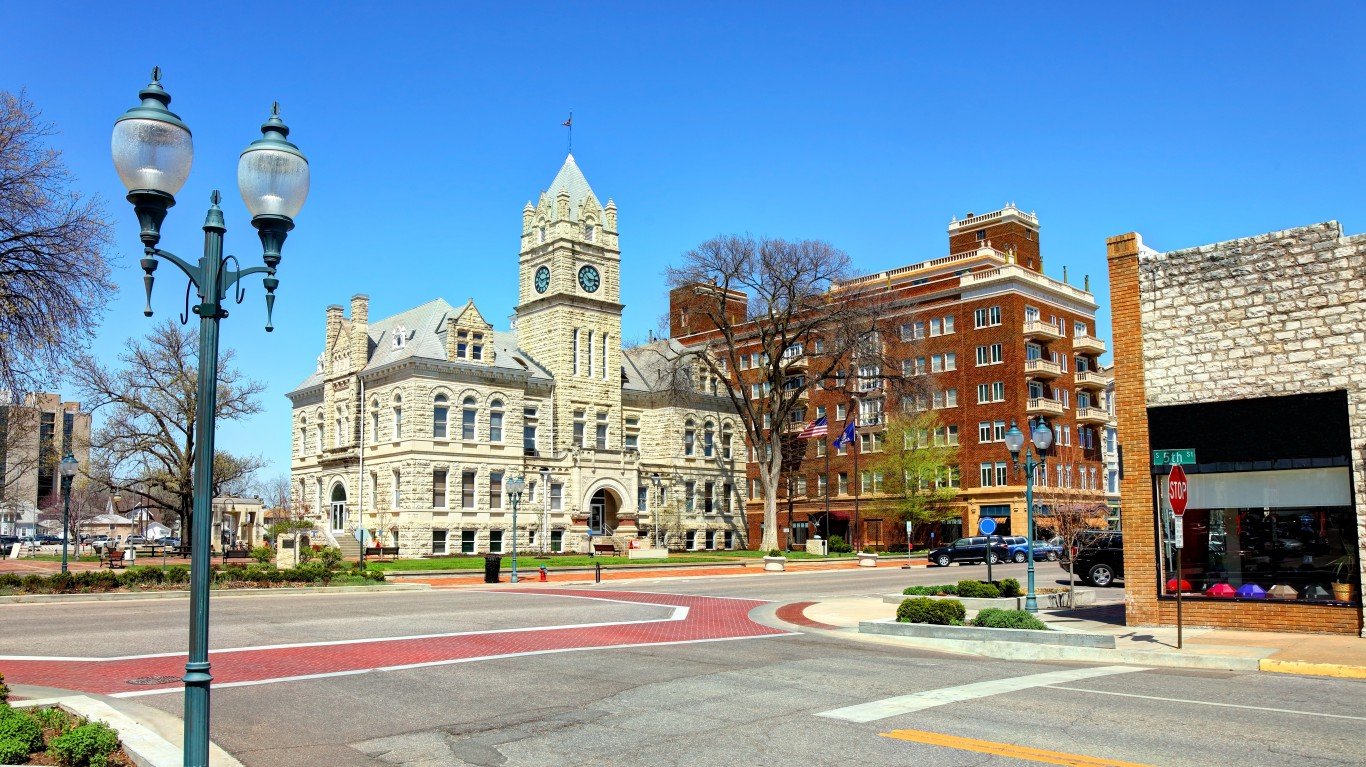
2. Manhattan, KS
> Homeownership rate: 49.1%
> Median home value: $180,500 — 192nd highest of 384 metros
> Median monthly housing costs (w/ a mortgage): $1,519 — 116th highest of 384 metros (tied)
> Median monthly housing costs (no mortgage): $563 — 81st highest of 384 metros (tied)
> Median household income: $54,488 — 125th lowest of 384 metros
[in-text-ad-2]

1. Los Angeles-Long Beach-Anaheim, CA
> Homeownership rate: 48.7%
> Median home value: $641,300 — 7th highest of 384 metros
> Median monthly housing costs (w/ a mortgage): $2,658 — 7th highest of 384 metros
> Median monthly housing costs (no mortgage): $648 — 39th highest of 384 metros
> Median household income: $76,399 — 40th highest of 384 metros
Methodology
To determine the metro areas with the lowest homeownership rates, 24/7 Wall St. reviewed five-year estimates of the share of housing units that are occupied by their owners from the U.S. Census Bureau’s 2020 American Community Survey. Metro areas were ranked based on the percentage of housing units that are occupied by their owners. To break ties, we used the number of housing units that are occupied by their owners.
We used the 384 metropolitan statistical areas as delineated by the United States Office of Management and Budget and used by the Census Bureau as our definition of metros.
Additional information on median home value, median housing costs with and without a mortgage, and median household income are also five-year estimates from the 2020 ACS. Because the Census Bureau didn’t release one-year estimates for 2020 due to data collection issues caused by the COVID-19 pandemic, all ACS data are five-year estimates.
Sponsored: Attention Savvy Investors: Speak to 3 Financial Experts – FREE
Ever wanted an extra set of eyes on an investment you’re considering? Now you can speak with up to 3 financial experts in your area for FREE. By simply
clicking here you can begin to match with financial professionals who can help guide you through the financial decisions you’re making. And the best part? The first conversation with them is free.
Click here to match with up to 3 financial pros who would be excited to help you make financial decisions.
Thank you for reading! Have some feedback for us?
Contact the 24/7 Wall St. editorial team.


 24/7 Wall St.
24/7 Wall St.
 24/7 Wall St.
24/7 Wall St.